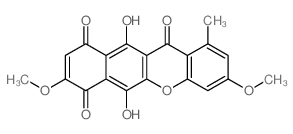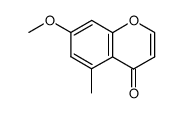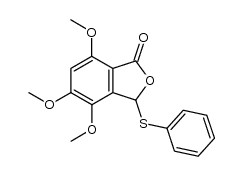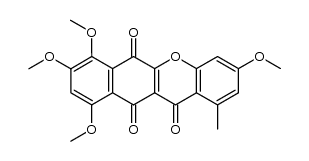33390-21-5
| Name | bikaverin |
|---|---|
| Synonyms |
Lycopersin
Bikaverin 6,11-dihydroxy-3,8-dimethoxy-1-methylbenzo[b]xanthene-7,10,12-trione |
| Description | Bikaverin (Lycopersin) is a reddish pigment produced by different fungal species. Bikaverin shows antibiotic properties against certain protozoa and fungi[1]. |
|---|---|
| Related Catalog | |
| In Vitro | Chemically, Bikaverin (Lycopersin) is a polyketide with a tetracyclic benzoxanthone structure, resulting from the activity of a specific class I multifunctional polyketide synthase and subsequent group modifications introduced by a monooxygenase and an O-methyltransferase[1]. Bikaverin is a reddish polyketide pigment produced by Gibberella fujikuroi in addition to large amounts of gibberellins[2]. |
| References |
[1]. Limón MC, et al. Bikaverin production and applications. Appl Microbiol Biotechnol. 2010;87(1):21-29. |
| Density | 1.61g/cm3 |
|---|---|
| Boiling Point | 719.8ºC at 760mmHg |
| Molecular Formula | C20H14O8 |
| Molecular Weight | 382.32000 |
| Flash Point | 263.3ºC |
| Exact Mass | 382.06900 |
| PSA | 123.27000 |
| LogP | 2.58370 |
| Index of Refraction | 1.711 |
CHEMICAL IDENTIFICATION
HEALTH HAZARD DATAACUTE TOXICITY DATAMUTATION DATA
|
| Symbol |

GHS06 |
|---|---|
| Signal Word | Danger |
| Hazard Statements | H301 |
| Precautionary Statements | P301 + P310 |
| RIDADR | UN 2811 6.1 / PGIII |
| RTECS | DM2901000 |
| Precursor 7 | |
|---|---|
| DownStream 0 | |

![11-hydroxy-3,8,10-trimethoxy-1-methylbenzo[b]xanthen-12-one structure](https://image.chemsrc.com/caspic/078/83375-27-3.png)





